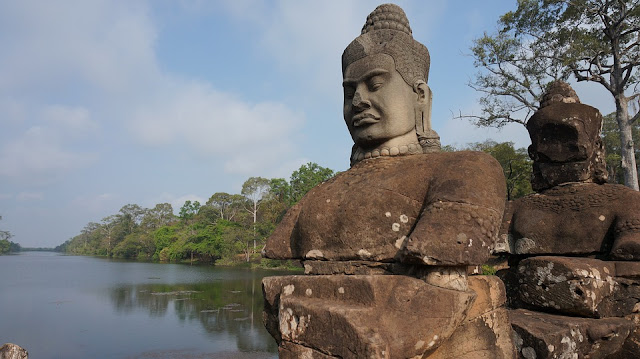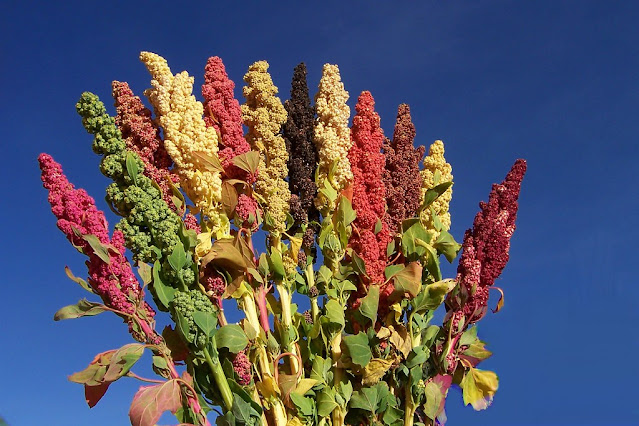Angkor Wat Temples of Cambodia
A note on the Angkor Wat Temple Complex, Siem Reap, Cambodia
The Angkor Wat temples in Siem Reap, Cambodia are the remnants of an ancient lost Kingdom of the Khmer Kingdom. The whole temple complex is a UNESCO designated World Archaeological Heritage Site and the massive rock reliefs qualify for the most superlative descriptions and eulogies in poetic expressions of creativity that are attributed to the Kings of the ancien regime.
Research is still a work in progress, but it ain't rocket science to figure the tenets of Buddhist and Hindu philosophies in these temples. Indeed the English word 'serpentine' owes its etymological - and cultural genesis to the Samudra Mathana scene of the Mahabharatha the great Hindu Eipc where the demon kings are defeated in a contentious scene by the Gods and angels in an effort to draw on the elixir of life all the precious wealth of humankind that has ostensibly sunk into the sea. I
believe that the literary epics and culture of Asia are actually a geo-morphological chronicle of the natural history of the region.
"The reference of
‘Samudra Manthana', the Churning of Ocean is found primarily in Bhagavata Purana,
Vishnu Purana and Mahabharata.
The Devas who represent positive cosmic forces
and the Asuras representing negative forces come together to churn the
Ocean. The origin of this activity goes
back to the event when Indra, king of
Devas lost all the wealth as the result of a curse by the sage Durvasa. The Devas wanted to churn the Ocean to get back
their wealth which was sunk in the deep Sea and Amrita (nectar) which grants long
life and abundant energy (immortality). They
seek the help of Asuras since the task needed more force. Asuras came to help with the agreement of
sharing the wealth and the Amrita which would come out as the result of
churning of Ocean.
Garuda, vehicle of Vishnu brought the mountain
Mandara which was used as churning rod to the milky Ocean. Vasuki, the giant serpent that adores the neck
of Shiva came down to help as rope. Lord Vishnu came down in his Kurma avatar, huge
turtle to hold the mountain Mandara high like an island. The Devas pulled the
snake at its tail end and the Asuras held the head. The churning went on for 1000 years.
The toxic poison (halahala) emerged first from
the bottom of the Sea which would have destroyed the entire creation. Lord Shiva swallowed the poison and held it in his throat. A
number of precious things came out that were shared by both Devas and Asuras. Kamadhenu, Uchhaishravas, the
7-headed horse, Airavata, the white elephant, Parijat, the tree with
never-fading blossoms, Apsaras etc. Goddess
of wealth Lakshmi who is wife of Lord Vishnu and the Chandra, the Moon which
adorns Lord Shiva's head came out eventually.
Finally came out Amrita in a pot held by Dhanvantari, the divine
physician. The Devas and Asuras both
tried to get hold of the pot of Amrita.
There would have been
total devastation in the world with negative forces if Asuras had got hold of
Amrita which would have made them immortal (long span of life). Lord Vishnu saved the world by distributing
Amrita only to Devas taking the form of a beautiful damsel, Mohini.
Spiritually, Samudra Manthana symbolizes the constant
struggle of both good and evil forces in human mind to win over the other.
When this task of churning took place ?
In Satyayuga, before Tretayuga. Mahabharata war took place around 3100 B.C.E
according to the technical support available now. We may place lower date of Satyayuga as 8000
BC.
I got this
information in a book. Not sure but you may see.
According to the mythology, the ocean of milk is the fifth from the centre of the seven
oceans. It used to cover a continent called as KRAUNCHA .
According to a thesophist, krauncha was a supercontinent ( the whole afroeurasia, Australia, both
Americas and Antarctica combined) before the continental drift. And the ocean
of milk that was covering it, is the whole water body of the earth. So it is
very difficult to know the exact location of that. But I may say that the
location can be reverse point from the centre of the supercontinent ( that is
exactly to end of the axle if the axle is passed through that centre of the
krauncha)" according to Vedic Scholar Dr. Jayanthi Manohar.
That apart the towers over the sanctum sanctorum of the Angkor Wat Temple - the Gopuras signified the astronomical Knowledge of this civilisation. The Gopuras served as telescopes for a culture that subscribed to the wisdom of the lunar almanac. The synchronicity of the lunar almanac finds fruition in the symmetrical construction of the Gopuras which align with sunrise on the four different solstice days of the Buddhist / solar and Christian calendars too. The cosmopolitan and indeed secular credentials of the Khmer Kingdom indeed needs emulation in an unfair war torn New World Order!
Other scientific tenets portrayed in the stone carvings include secrets of magnetic energy being absorbed through adornment of jewelry by both men and women, seismic code in architecture, weather forecasting, agrometeorological wisdom of the lunar almanac, Mental Health guidelines in archaeology and architecture, all of which resonate in Vedic hymns in the hallowed precincts of pillared corridors in the temples of Angkor; Besides, there are tenets and precepts of astronomy, sustainable development, political ecology, sexuality, political wisdom, metaphysical / philosophical tenets, and astonishingly there is resonance of modern science and technology in the ancient architecture: the quincunx is believed by some to represent a cross section view of the solar system - a latter day 3 D printed image - if you will - of the Solar system in the Milky Way. In so many ways the Angkor Temples represent the repository of Vedic Knowledge.
A detailed visit of the Angkor Archaeological Park in Siem Reap in Cambodia is rewarding in more ways than one to visitors of all ages, abilities, race, culture, language and education.
The corridors surrounding the main temple in Angkor Wat were vestibules housing guardian images, according to the book "Ancient Angkor" by Michael Freeman and Claude Jacques.
The Ta Prohm or the Brahma temple and Preah Khan temples are invaded by the jungle... picturising for us the concept of re-wilding in a live lecture so to say. It presents the greatest challenge to UNESCO whether to restore the temples or to preserve the inheritance of the jungle clad temples. But the temples of Angkor are a photographer's delight and a poetic fantasy for culture vultures.
To me this can easily pass off for a bicameral legislature with all the dignity that the columns and towers bring to statecraft...
Angkor Wat: Central temple mountain with quincunx of towers
Angkor Wat Wikipedia
Angkor Wat - 7th Wonder of the World
Credits:
Pictures, Malini Shankar, & Pixabay,
Text: Malini Shankar Digital Discourse Foundation https://digitaldiscourse.org.in



























































































































































































































































Excellent information Malini madam.
ReplyDeleteOh thank you
Delete